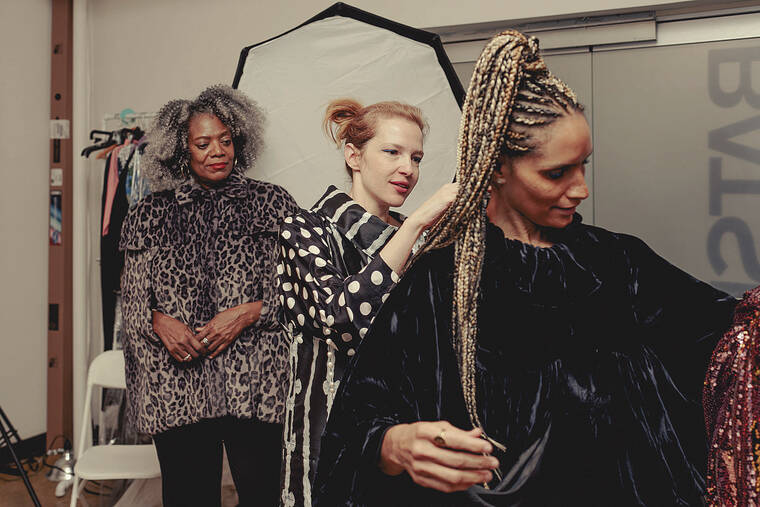Models wanted: must be over 40

NEW YORK TIMES
Vanessa Place, a poet and lawyer in her 50s, tried on a dress in preparation for Batsheva’s Fashion Week runway show on Feb. 13, in New York last month. It was Place’s first time on the runway.

NEW YORK TIMES
Gwen DeVoe (left, in leopard) and Racquel Chevremont (right, in velvet), tried on clothes for Batsheva’s Feb. 13 Fashion Week runway show, in New York last month. The fashion label dared to cast middle-age and older women for the runway.


NEW YORK >> Over several weeks in January, Batsheva Hay stopped women outside a dance studio, on the subway and inside a grocery store. She slid into strangers’ DMs.
You’re beautiful, she has told them in her warmest, most this-is-not-a-scam voice. Would you consider modeling?
Hay is a New York fashion designer, and this is how she cast her New York Fashion Week runway show. Street casting is nothing new — it is how fresh faces in fashion are often found, plucked from real life rather than from modeling agencies.
What is unusual is that Hay had only approached women who appear to be over 40.
Why 40?
“Because I’m 42,” Hay said. And she has complicated feelings about that. “I find that aging is a big preoccupation for me and my friends. It’s an area of discomfort in fashion.”
Don't miss out on what's happening!
Stay in touch with breaking news, as it happens, conveniently in your email inbox. It's FREE!
The discomfort took her by surprise when she turned 40. Everything in fashion suddenly looked “so young,” she said. Her relationship to clothing changed, which was rather alarming for someone whose occupation was clothing. She realized she was old enough to have mothered many of the models she saw in runway shows or advertising campaigns. In her social circle, Hay said, “everyone’s talking about whether they should start doing something with their face.”
It is not uncommon to see a woman older than 40 on the runway. Last year, Vogue called their presence an “invasion” (in a good way). But typically there is just one, and probably no more than three, in a cast of 30 or 50 or 80. Older models are tokenized in much the same way as plus-size models. Brands use them and seem more inclusive.
“I want to see more,” said model Birgitt Doss, 67. “I want to see them in underwear.” At that very moment, her underwear was visible through a Batsheva lace dress. She didn’t mind. “I love it,” Doss said. “I feel so much freer now. At 25, I was like, no!”
Doss modeled in the 1980s, she said, but couldn’t get work once she turned 30. Then, in 2018, she attended an open casting for Eckhaus Latta. Her career resumed; she has since modeled for Lemaire, Rachel Comey and Collina Strada, among others.
On a Wednesday night in late January, Doss was standing in Batsheva’s midtown Manhattan studio, trying on dresses for the Feb. 13 show. Hay was doing fittings — matching models to outfits and making sizing adjustments.
What is normally a fairly routine exercise in the work flow of a fashion show had become a sort of giddy group share.
“I’ve had so many friends who are like, ‘I’m in my invisible stage now,’” said Racquel Chevremont, 52, an art adviser with modeling experience. Hay found Chevremont on Instagram while browsing the account of a woman she had met on a train.
“One thing I noticed when stopping women,” Hay said. “They were like, ‘Me?’ There’s this feeling of invisibility or not being seen, so when you are seen it is very surprising.”
The first dress Chevremont tried on was made from a tablecloth that Hay had found at a hardware store in Brooklyn.
“I never thought about a plastic dress,” Chevremont said.
“It’s kind of futuristic on you,” Hay said.
This is the Batsheva aesthetic: Hay is a city-dwelling Laura Ashley (the two brands have collaborated), best known for prairie-style dresses that are modest but a little twisted. Hay was intrigued by the idea of invisibility even before turning 40. Dressing modestly can make you feel invisible, too.
“There’s this freedom,” she said. “No one’s ogling you.”
Not all of the women cast by Batsheva had modeled before. Vanessa Place, 55, is a friend of one of Hay’s employees. She is also a poet and criminal appellate lawyer, well-practiced in appearing before a crowd.
“To my mind, it’s the same as another performance,” she said when asked about her runway debut. “Mostly it’s about a sense of self.”
“There’s no wrong way to walk, if you ask me,” said Gwen DeVoe, 65, a human resources professional who acts, models and has organized a show for “silver fox” models older than 50. She tried on a faux-fur leopard-print cape. Hay noted her measurements so that she could make her a matching pair of pants.
Place, who was rereading “Antigone” while waiting for the fittings to begin, tried on a hooded dress.
“I did a lot of hoods,” Hay said. She had designed the collection with aging anxiety in mind, she said, experimenting with “droopiness” and “sagging.” She also made oversize bows that could be worn as turbans, inspired by the eccentric-looking older women she sees on the Upper West Side.
Hay said she planned to keep the models’ faces relatively bare for the runway show. In the past, she has used more theatrical hair and makeup.
“Here,” she said, “I don’t want anyone to feel like they’re trying to look younger.”




